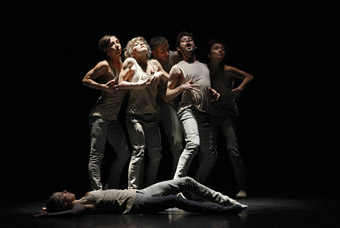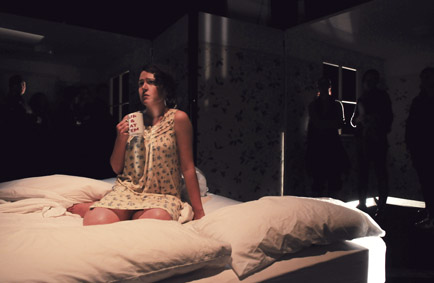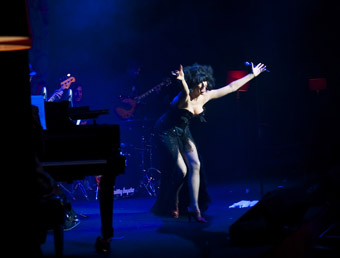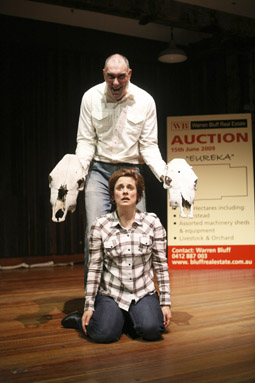altered states & mood swings
keith gallasch: sydney performance, theatre, dance, opera

Are We That We Are, Sydney Dance Company
photo Jeff Busby
Are We That We Are, Sydney Dance Company
HERE’S A COLLECTION OF REVIEWS OF QUITE DIVERSE WORKS SEEN OVER RECENT MONTHS WHICH I ADMIRED OR QUERIED, SOMETIMES BOTH, OVER MATTERS OF FORM AND HYBRIDITY. ALL HAD SOMETHING SPECIAL TO OFFER.
adam linder: are we that we are
In a RealTime interview (RT95), young Berlin-based Australian choreographer Adam Linder said of his new work for Sydney Dance Company, Are We That We Are, “I’m personally very interested in altered states, in what is fundamental to the right side of our brain—the sensory, the visionary, the experiential.” The outcome is unlike anything we’ve seen from the company, a series of strange images heightened by idiosyncratic choreography and lighting that dances. As if to suggest that the work takes place in one man’s mind, Linder enters the stage from the auditorium and sits at a desk from which he views a woman with a long rope controlling a horse-man, prancing hypnotically in a wide circle, trotting, falling. Figures unfurl from Linder’s desk. A voice-over speaks of being “reborn to the possibility of rapture.” An elaborate tangling of bodies entwines one woman (Natalie Allen) in particular, light states changing rapidly with each shift in the engagement, her body maximally expressive within the tightest of limits, the apparent indifference of her oppressors. A huge column of light descends like the rolling monolith from 2001: A Space Odyssey (a favourite of ecstasy seekers) but emitting rich, fluid colour states against epic neo-60s guitar as Linder and Charmene Yap, in the demanding centrepiece of the work lock into a sensual knot, a two-headed creature, Kama Sutra-ish. They work close to the floor, driven, disorienting in their relationship to the illuminating, alien surveillor hanging above.
In a big mood swing, a chorus line, arms linked, prance in like a row of Norman Lindsay fauns—soon Linder will ride them like a king on a chariot. In the final scene, as a disturbing bass line distorts, the dancers emerge upstage holding balloons, moving forward, glowing, Linder amongst them, but eventually reversing as if he’s in this, but not of it, echoing the work’s opening. The dramas of control and release, the sci-fi-ish and sexual evocations, group fantasies and the final smiling love-in (a relatively unremarkable scene) are what we expect of altered states but are here imbued with a disturbing otherness and enriched by imaginative choreography and committed dancing, not least from Linder himself, and superb lighting by Nick Schlieper. Are We That We Are was on a double bill with Rafael Bonachela’s 6 Breaths.

Clare Britton, Hole in the Wall, Performance Space
photo Heidrun Löhr
Clare Britton, Hole in the Wall, Performance Space
hole in the wall
Matt Prest and Clare Britton’s Hole in the Wall is above all a uniquely engaging sensory experience. In four groups of 10 we are ushered into small wall-papered, low-ceilinged rooms in the performance space. The door slams shut behind us, the windows are closed. The room moves. We move to keep up (the rooms are on wheels, we are walking on the performance space floor). We have no idea where we are. The room stops and we are plunged into darkness from which emanates an anxious male voice bewailing lost opportunities, uncertain futures and the relative pleasures of mortality. Lights up and we’re on the move again. The doors open and we face a bed and the other rooms and our fellow audience—we’ve formed a house. A woman struggles with a mattress as if being devoured by it, crying for help until interrupted by her male partner who doesn’t get this game (which is perhaps little different from the anxious musings to which we’ve just been submitted). They settle down, murmuring further anxieties in their restless sleep in an off-kilter dialogue. That’s how the show works, without giving away too much more, save that the rooms are locked in other configurations and that the couple display their anxieties in monologues, literally running arguments, a dance (part erotic, part threatening) and some nervous partying.
At the core of this couple’s anxieties are dreams of perfection pitched against the blandness of contemporary living and complicated by communication problems. Each performer evinces a comfortable physical presence, wandering among us, appearing through a window, darting through slammed doors. Vocally though they’re less comfortable, Britton too loud in what is after all an intimate space, Prest a tad over-nuanced in his delivery and both slipping into conventional acting intonation when they need to find a performative voice equal to the strange world they have created spatially. This problem is amplified by a tame script that while calculatedly deploying the cliches of domestic argument and everyday existential crises lacks the specificity and poetry with which, again, to match the distinctiveness of the rest of the artists’ creation. The ending too is sentimental: given the multiplying tensions and outpourings of angst, it’s too easily resolved. I wonder also, about our role as audience, simply occupying rooms like ghosts or unacknowledged guests (save in the party scene). For all this, Hole in the Wall remains a memorable experience, part fun disorientation, part Bachelard-on-wheels and definitely worthy of a longer and more developed life.

Meow Meow at Late Night Lounge, Sydney Opera House
photo Justin Malinowski
Meow Meow at Late Night Lounge, Sydney Opera House
meow meow: meow to the world
Meow Meow was in town, “back by her own demand”, with a return season of Meow to the World: Crisis is Born, a scabrous out-of-schedule Xmas celebration of the Global Financial Collapse. Compared with her other shows, where her high maintenance neediness (it’s still here) dominates, this Meow Meow is up there with Stephen Colbert of the Colbert Report, walking the satirical knife edge of simultaneously playing out and undercutting the kind of vicious selfishness that free market narcissism yields, not least during economic downturns. She provides the flowers for the audience to throw for her sumptuous, gorgeously frocked opening but then commences to savagely cost-cut, complaining (“Did anyone bring any atmos? Do I have to do everything!”; “No smoking? I might as well have brought an extra large Ventolin), stripping herself and her band of their clothes (“the Opera House cut the dry-cleaning budget”). She steals drinks and food from the audience (“Just looking for a cheese platter. The Opera House didn’t feed us”) and introduces three local youngsters (“the orphans—we ordered three”). These she then ruthlessly exploits, bullying them through “My Favorite Things” and “Silent Night” before propelling them into the audience to beg for money.
But there are more rewards than clever satire as dark songs like the Dresden Dolls’ “Missed ME” and Nick Cave’s Red Right Hand deepen the mood, while more buoyant classics, art house and popular, reflect the mood swings of our times. Meow Meow is in more than excellent voice, the band, led by New Yorker Lance Horne is top notch and I leave Meow to the World heartened that cabaret can still bite. Meow to the World: Crisis is Born premiered in New York in 2008 and won Best Cabaret in the Sydney Theatre Awards for 2009.
the folding wife
A very welcome Mobile States tour of The Folding Wife is taking this inventive and culturally idiosyncratic production to a wide audience. Jan Cornall’s review of the original production, “One woman in many: survival and resilience” (RT 79) says it all: “The audience is left with sensual impressions of lace and blood, laughter and sorrow, ‘roasted corn on Sundays, coloured parasols reflecting the white heat of the sun’ and a heritage of women, strong, beautiful and dignified, who have survived on memories of a glorious past or a projected future as they bent and folded into themselves a nation’s pain.” I recommend you read the whole review.
The particular power of The Folding Wife emanates from the construction of the work as a living installation—Valerie Berry (deftly playing the female generations of one family) is casually sculpted and adorned into shape by two on-stage artists using clothing, props and projections. It’s as if we are witnessing the forces of family, history, politics and culture (Filipino and then Australian) shaping a life which, in the end, refuses manipulation. Strong physical gestures (an Imelda Marcos shoes routine is a highlight), sensual, if sometimes alarmingly visceral screen images (we simultaneously witness their making), and lateral story-telling align with a poetic text to yield a curiously contemplative experience—of a work of art in more than a simply theatrical sense.

Stefo Nantsou, Lindy Sardelic, Burnt, Zeal Theatre
photo Tracey Schramm
Stefo Nantsou, Lindy Sardelic, Burnt, Zeal Theatre
burnt
To see the Zeal Theatre trio performing Burnt is to witness a company hard at work, as a very good band (whose instruments double as FX devices), amiable hosts and excellent actors, initially as a farming family rounding up sheep and then, virtuosically, adding a large number of other characters from a drought-stricken rural community. The story is sadly predictable if rooted in fact (the company had done on-the-ground research into growing poverty, probable loss of an inherited property, desperate measures, new multicultural pressures, family tensions and the potential for suicide) but is written with wicked wit and a touch of pathos and performed with remarkable precision—just the right amount of idiosyncratic personality touches and the capacity to shape the multitude of scenes like a team of adroit film editors. Other playwrights could learn much from them. This is bare bones theatre of the highest order—a few sheep and cattle skulls litter the stage with a car seat and an oil drum; the rest is embodied in these truly engaging performers.
fox
Writer Margaret Wild and illustrator Ron Brooks’ Fox is an award winning picture book for young people about a bushfire-injured magpie aided by a one-eyed dog. Their relationship is sundered when a fox promises more than the dog can offer. The book’s storytelling is very spare, while the opera version is theatrically and musically elaborate. An ever present soprano (her character otherwise undefined) is the only singer and delivers the narration (Sarah Jones has a fine voice but is at her best in lower registers where consonants remain intact) while three performers enact the animals, but in several and inevitably confusing modes—as actors, as puppeteers and in projections.
Unlike Red Leap’s adaptation of Shaun Tan’s The Arrival (RT95) which was for the most part faithful to the author’s aesthetic, this account of Fox further complicates things by gendering the scenario—the fox is a handsome, swaggering male seducer and magpie a helpless female, with their stylish costuming taking us a long way from the book’s plain, bush reality. While there are moments of evocative puppeteering, brisk action and a dash of comedy from the dog, each episode is framed by song in the operatic mode (not always immediately memorable) yielding longeurs that flatten the drama, despite director Kate Gaul’s inventiveness. There is some attractive writing from composer Daryl Wallis but it’s not integrally dramatic, dominating rather than serving the story. For bringing new opera to young audiences, Fox is to be admired, if in the process revealing the challenges of adaptation.
–
Sydney Dance Company, New Creations, Are We That We Are, choreography Adam Linder, dramaturgy Sally Schonfeldt, costumes Jordan Askill, lighting Nick Schlieper, sound Adam Synnott; Sydney Theatre, March 23-April 10; Hole in the Wall, concept, performance, design Matt Prest, Clare Britton, concept, director Hallie Shellam, text Halcyon Macleod, lighting design Mirabelle Wouters, concept, set Danny Egger, sound, animation James Brown; Performance Space, CarriageWorks, May 26-29; Meow Meow, Meow to the World: Crisis is Born, The Studio, Sydney Opera House, March 2-14; Urban Theatre Projects, The Folding Wife, performer Valerie Berry, writer Paschal Daantos Berry, director Deborah Pollard, design, multimedia Anino Shadowplay Collective, lighting Neil Simpson, Performing Lines for Mobile States; Performance Space, CarriageWorks, Sydney, May 19-22; Zeal Theatre, Burnt, writer-performers Tom Lycos, Stefo Nantsou, performer; Lindy Sardelic, director Stefo Nantsou, music Tom Lycos, Wharf 2, Sydney Theatre Company, May 25-28; Fox, Monkey Baa with Siren Theatre Co, director Kate Gaul, composer Daryl Wallis, performers David Buckley, Jay Gallagher, Sarah Jones, Jane Phegan, designer Gabriela Tylesova, lighting Designer Luiz Pampolha, Seymour Centre, Sydney, April 10-17
RealTime issue #97 June-July 2010 pg. 37






